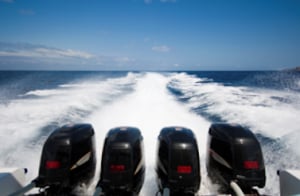 The Navigational Rules of the Road (Rule 6) states that you need to set a safe speed in all conditions of visibility. This obviously does not mean the same “safe speed” applies in good as well as restricted visibility. The first requirement of this rule is to consider what the state of visibility is because safe speed in any condition must be closely related to the immediate circumstances and conditions at hand. A boat at high speed has a large amount of force. With an untrained operator, this force can be dangerous.
The Navigational Rules of the Road (Rule 6) states that you need to set a safe speed in all conditions of visibility. This obviously does not mean the same “safe speed” applies in good as well as restricted visibility. The first requirement of this rule is to consider what the state of visibility is because safe speed in any condition must be closely related to the immediate circumstances and conditions at hand. A boat at high speed has a large amount of force. With an untrained operator, this force can be dangerous.The following different factors should be considered to determine safe speed:
- Heavy seas: Slow down as winds and seas increase; the boat will handle more easily. Pounding or becoming airborne fatigues the hull and could injure your crew or cause them chronic body aches and pains.
- Traffic density: Do not use high speed in high traffic density areas. A safe speed allows response to developing situations and minimizes risk of collision, not only with the nearest approaching vessel, but with others around it.
- Visibility: If conditions make it difficult to see, slow down. Fog, rain, and snow are obvious limits to visibility, but there are others. Visible features and obstructions (river bends, piers, bridges and causeways), along with heavy vessel traffic, can limit the view of “the big picture.” Darkness or steering directly into the sun lessens ability to see objects or judge distances. Prevent spray on the windscreen (particularly salt spray or freezing spray) as much as possible and clean it regularly. Spray build-up on the windscreen is particularly hazardous in darkness or when you experience glare.
Besides Heavy Seas, Traffic Density, and Visibility, there are additional external factors that will have an effect on your vessels ability to run at a safe speed.
In shallow water, the bottom has an effect on the movement of the vessel. Slow down in shallow water. In extremely shallow water, the vessel’s stern tends to “squat” and actually moves closer to the bottom.
In narrow channels and canals, a vessel moving through the water will cause the “wedge” of water between the bow and the nearer bank to build up higher than on the other side. This bank cushion tends to push the bow away from the edge of the channel.
When meeting another vessel close aboard, bow cushion and stern suction occur between the vessels much the same as bank cushion and suction. Helm corrections should be used to compensate. As both vessels move through the water, the combined effect is greater than what a single vessel encounters from bank interaction. Caution should be used so the bow does not veer too far from the intended track and the stern swings into the path of the other vessel.
All vessels are responsible for their wake and any injury or damage it might cause. Only a poorly trained or ignorant boat operator trails a large wake through a mooring area or shallows, tossing vessels and straining moorings. A large, unnecessary wake, particularly in enclosed waters or near other smaller vessels, is unnecessary and can cause damage or injure others.




Let Us Know What You Thought about this Post.
Put your Comment Below.